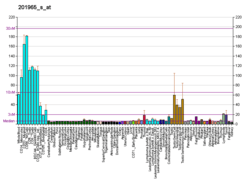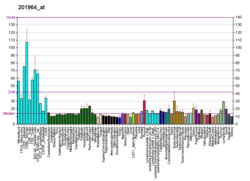SETX
Probable helicase senataxin is an enzyme that in humans is encoded by the SETX gene.[5][6][7]
This gene encodes a protein named for its homology to the Sen1p protein of fungi which has RNA helicase activity encoded by a domain at the C-terminal end of the protein. The protein encoded by this gene contains a DNA/RNA helicase domain at its C-terminal end which suggests that it may be involved in both DNA and RNA processing. Mutations in this gene have been associated with Ataxia oculomotor apraxia type 2 (AOA2) and an autosomal dominant form of juvenile amyotrophic lateral sclerosis (ALS4).[7]
References
- GRCh38: Ensembl release 89: ENSG00000107290 - Ensembl, May 2017
- GRCm38: Ensembl release 89: ENSMUSG00000043535 - Ensembl, May 2017
- "Human PubMed Reference:". National Center for Biotechnology Information, U.S. National Library of Medicine.
- "Mouse PubMed Reference:". National Center for Biotechnology Information, U.S. National Library of Medicine.
- Chance PF, Rabin BA, Ryan SG, Ding Y, Scavina M, Crain B, Griffin JW, Cornblath DR (Apr 1998). "Linkage of the gene for an autosomal dominant form of juvenile amyotrophic lateral sclerosis to chromosome 9q34". Am J Hum Genet. 62 (3): 633–40. doi:10.1086/301769. PMC 1376963. PMID 9497266.
- Nemeth AH, Bochukova E, Dunne E, Huson SM, Elston J, Hannan MA, Jackson M, Chapman CJ, Taylor AM (Nov 2000). "Autosomal recessive cerebellar ataxia with oculomotor apraxia (ataxia-telangiectasia-like syndrome) is linked to chromosome 9q34". Am J Hum Genet. 67 (5): 1320–6. doi:10.1016/S0002-9297(07)62962-0. PMC 1288574. PMID 11022012.
- "Entrez Gene: SETX senataxin".
External links
Further reading
- Maruyama K, Sugano S (1994). "Oligo-capping: a simple method to replace the cap structure of eukaryotic mRNAs with oligoribonucleotides". Gene. 138 (1–2): 171–4. doi:10.1016/0378-1119(94)90802-8. PMID 8125298.
- Bonaldo MF, Lennon G, Soares MB (1997). "Normalization and subtraction: two approaches to facilitate gene discovery". Genome Res. 6 (9): 791–806. doi:10.1101/gr.6.9.791. PMID 8889548.
- Suzuki Y, Yoshitomo-Nakagawa K, Maruyama K, et al. (1997). "Construction and characterization of a full length-enriched and a 5'-end-enriched cDNA library". Gene. 200 (1–2): 149–56. doi:10.1016/S0378-1119(97)00411-3. PMID 9373149.
- Ishikawa K, Nagase T, Suyama M, et al. (1998). "Prediction of the coding sequences of unidentified human genes. X. The complete sequences of 100 new cDNA clones from brain which can code for large proteins in vitro". DNA Res. 5 (3): 169–76. doi:10.1093/dnares/5.3.169. PMID 9734811.
- Strausberg RL, Feingold EA, Grouse LH, et al. (2003). "Generation and initial analysis of more than 15,000 full-length human and mouse cDNA sequences". Proc. Natl. Acad. Sci. U.S.A. 99 (26): 16899–903. Bibcode:2002PNAS...9916899M. doi:10.1073/pnas.242603899. PMC 139241. PMID 12477932.
- Ota T, Suzuki Y, Nishikawa T, et al. (2004). "Complete sequencing and characterization of 21,243 full-length human cDNAs". Nat. Genet. 36 (1): 40–5. doi:10.1038/ng1285. PMID 14702039.
- Moreira MC, Klur S, Watanabe M, et al. (2004). "Senataxin, the ortholog of a yeast RNA helicase, is mutant in ataxia-ocular apraxia 2". Nat. Genet. 36 (3): 225–7. doi:10.1038/ng1303. PMID 14770181.
- Chen YZ, Bennett CL, Huynh HM, et al. (2004). "DNA/RNA helicase gene mutations in a form of juvenile amyotrophic lateral sclerosis (ALS4)". Am. J. Hum. Genet. 74 (6): 1128–35. doi:10.1086/421054. PMC 1182077. PMID 15106121.
- Humphray SJ, Oliver K, Hunt AR, et al. (2004). "DNA sequence and analysis of human chromosome 9". Nature. 429 (6990): 369–74. Bibcode:2004Natur.429..369H. doi:10.1038/nature02465. PMC 2734081. PMID 15164053.
- Gerhard DS, Wagner L, Feingold EA, et al. (2004). "The status, quality, and expansion of the NIH full-length cDNA project: the Mammalian Gene Collection (MGC)". Genome Res. 14 (10B): 2121–7. doi:10.1101/gr.2596504. PMC 528928. PMID 15489334.
- Duquette A, Roddier K, McNabb-Baltar J, et al. (2005). "Mutations in senataxin responsible for Quebec cluster of ataxia with neuropathy". Ann. Neurol. 57 (3): 408–14. doi:10.1002/ana.20408. PMID 15732101.
- Asaka T, Yokoji H, Ito J, et al. (2006). "Autosomal recessive ataxia with peripheral neuropathy and elevated AFP: novel mutations in SETX". Neurology. 66 (10): 1580–1. doi:10.1212/01.wnl.0000216135.59699.9b. PMID 16717225.
- Beausoleil SA, Villén J, Gerber SA, et al. (2006). "A probability-based approach for high-throughput protein phosphorylation analysis and site localization". Nat. Biotechnol. 24 (10): 1285–92. doi:10.1038/nbt1240. PMID 16964243.
- Olsen JV, Blagoev B, Gnad F, et al. (2006). "Global, in vivo, and site-specific phosphorylation dynamics in signaling networks". Cell. 127 (3): 635–48. doi:10.1016/j.cell.2006.09.026. PMID 17081983.
- Suraweera A, Becherel OJ, Chen P, et al. (2007). "Senataxin, defective in ataxia oculomotor apraxia type 2, is involved in the defense against oxidative DNA damage". J. Cell Biol. 177 (6): 969–79. doi:10.1083/jcb.200701042. PMC 2064358. PMID 17562789.
This article is issued from Wikipedia. The text is licensed under Creative Commons - Attribution - Sharealike. Additional terms may apply for the media files.





